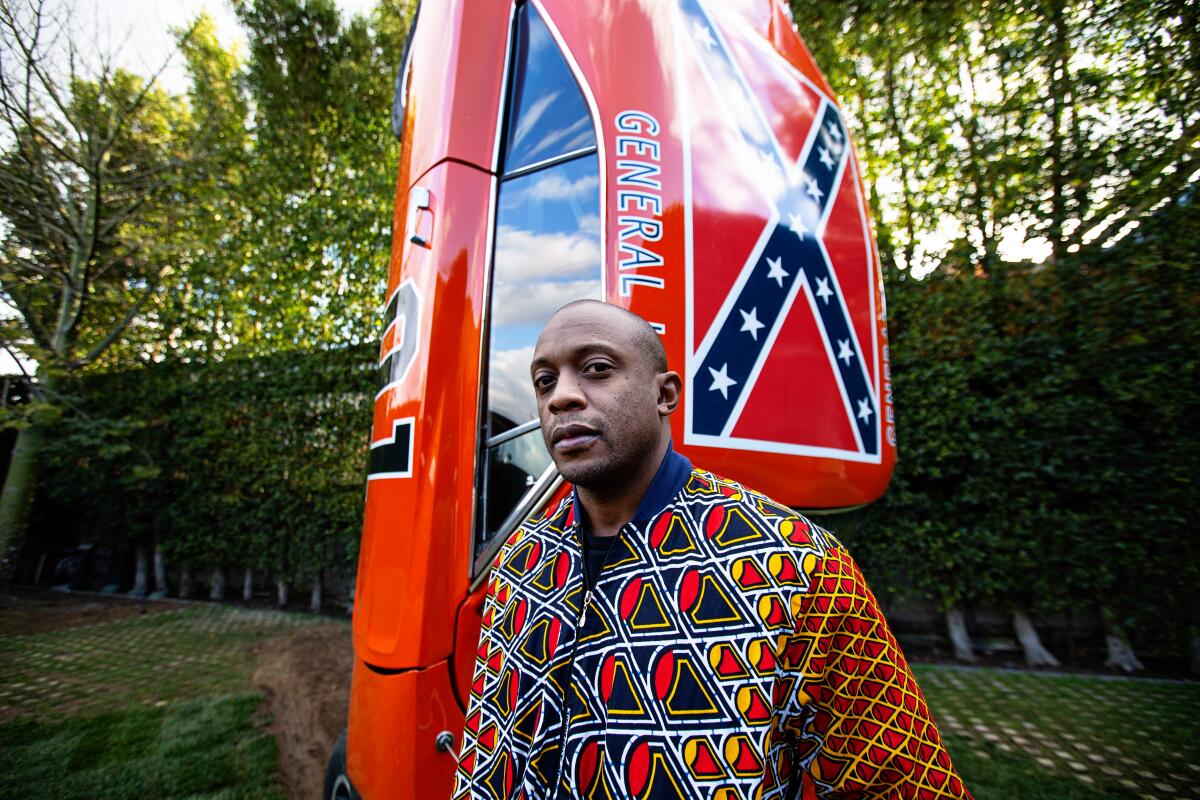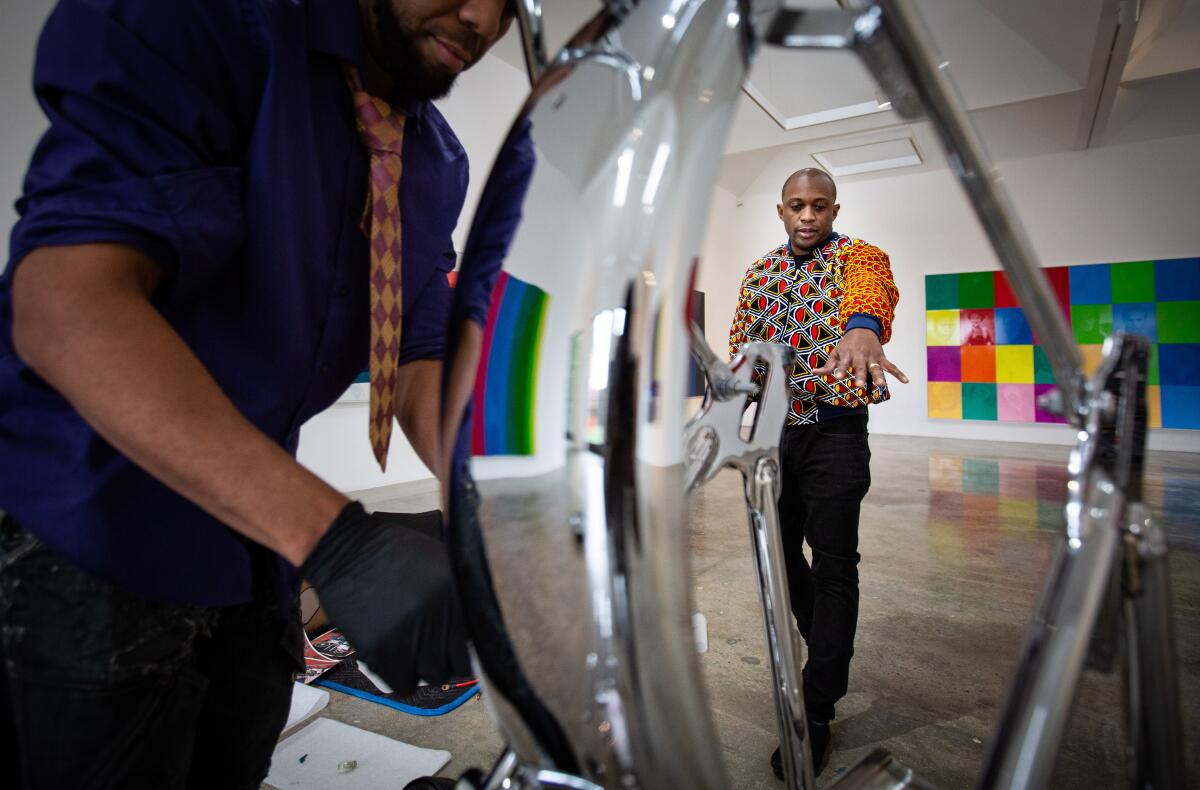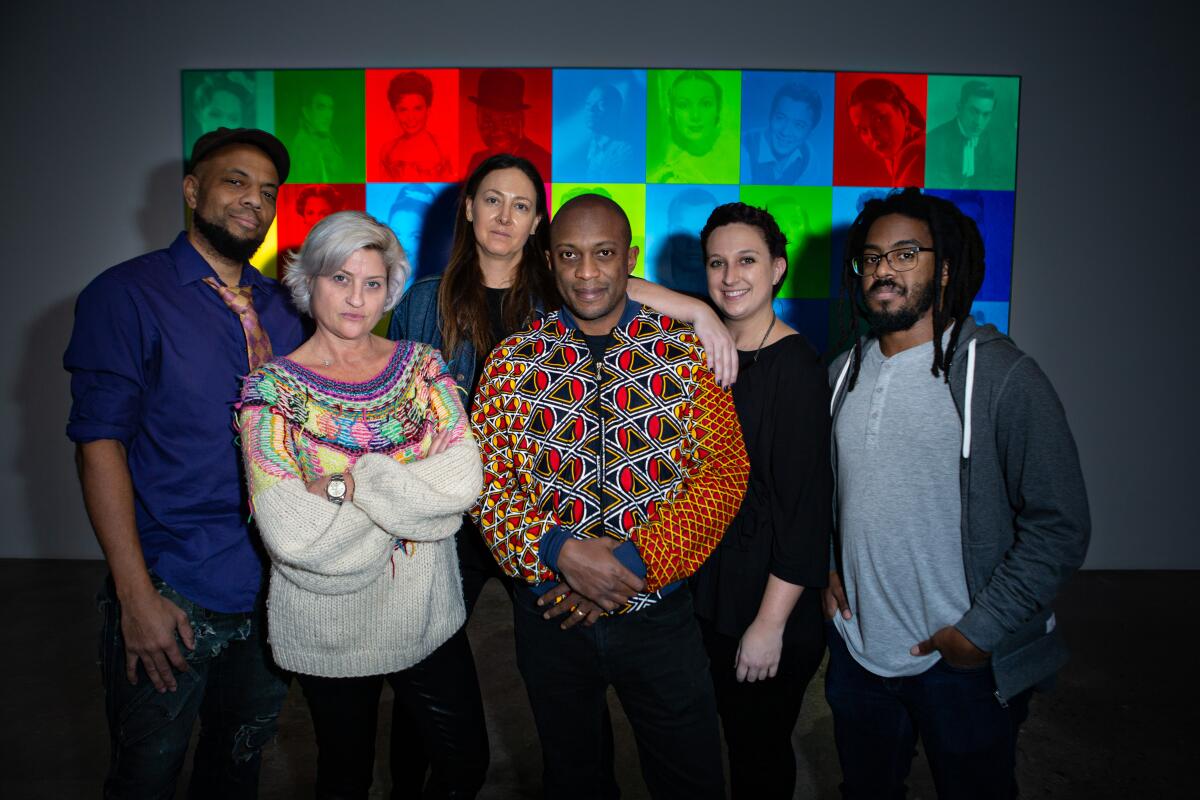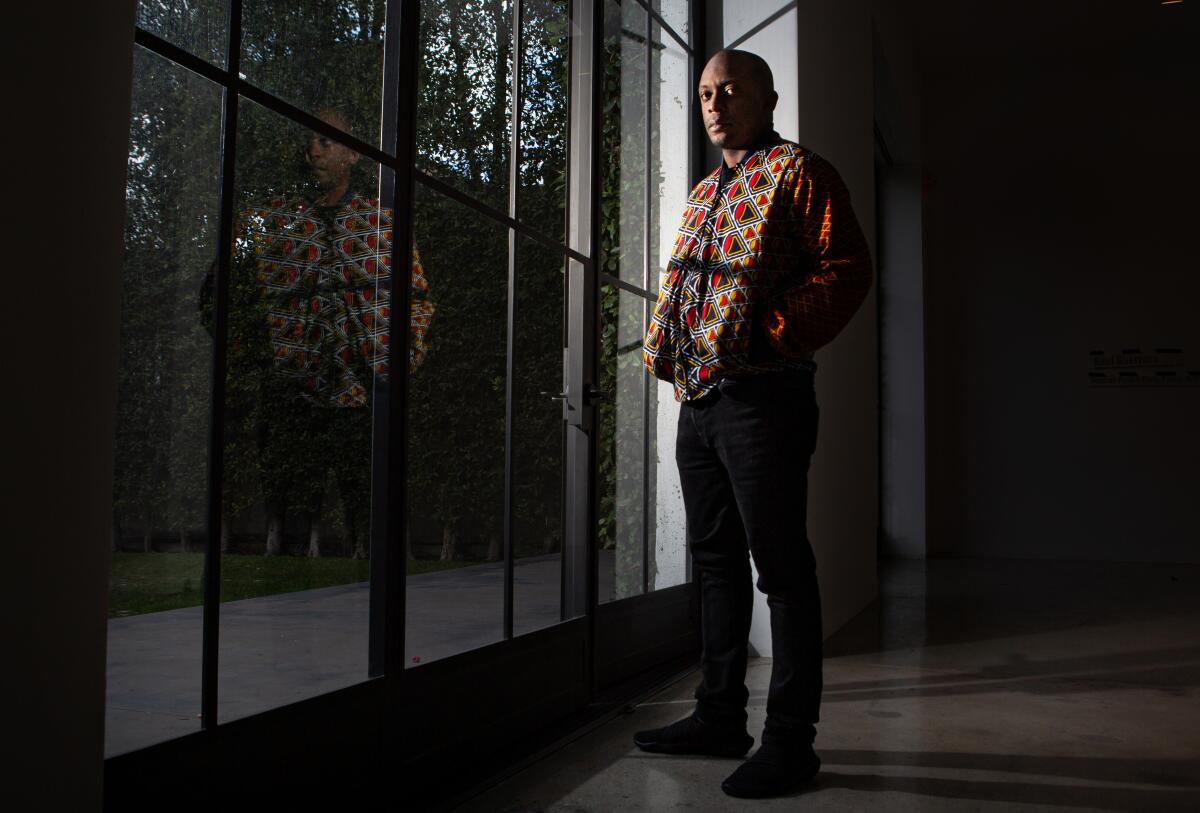Why artist Hank Willis Thomas smashed up ‘The Dukes of Hazzard’s’ General Lee

- Share via
There’s been an accident.
That’s what may enter your mind when you step through the front gate at Kayne Griffin Corcoran in Los Angeles and see a car lodged nose first in the gallery’s garden. Beyond that, indoors, lie pieces of a motorcycle that appears to have disintegrated mid-cruise.
This, however, is no accident.
The car is a Dodge Charger. Bright orange. Emblazoned with a Confederate battle flag on the roof and the words “General Lee” just over the windows — a facsimile of the 1969 souped-up ride that roared through seven seasons of CBS’ “The Dukes of Hazzard” during the early 1980s. The dismembered motorcycle is a chopper, just like the famous “Captain America” driven by Peter Fonda in the 1969 counterculture flick “Easy Rider.” A star-spangled helmet lies face-down nearby.
These cinematic collisions at the Mid-Wilshire gallery Kayne Griffin Corcoran are part of artist Hank Willis Thomas’ first solo gallery show in Los Angeles in more than a decade.
For Thomas, 43, these vehicular icons are more than just pop culture lore. As a kid growing up in New York, “The Dukes of Hazzard” was his favorite show; the General Lee a coveted toy.
“I had the car and I had the Bo and Luke action figures,” he says as he surveys the towering Charger. “Me and my friends — African Americans — we’d play ‘Dukes of Hazzard.’ ... My grandmother watched it with me. My mother watched it with me. There was never any mention or suggestion that there was a problem with the context or the Confederate flag.”
This anecdote tells a profound story — about how a symbol associated with the battle to maintain a slave-holding state, one deployed during the height of Jim Crow as a tool of intimidation, could be re-insinuated into the culture, often denuded of its original intent. And how Hollywood, in some cases, was happy to do the denuding.
“The Dukes of Hazzard” was a comedy about a pair of good ol’ boys engaging a comically inept sheriff and his droopy-eyed dog in spectacular car chases ...
... in a vehicle named for a Confederate general.

Color theory
It’s not the first time Thomas has taken on the Confederate flag in his work. In 2016 at the California African American Museum, he re-imagined it in the colors of the pan-African flag in an interactive video installation — a work that Times art critic Christopher Knight described as “enthralling.”
Thomas says he is interested in how these symbols travel through the culture, but also how African Americans digest them. He pulls out his cellphone and plays the 1990s-era single “Dazzey Duks,” by Florida rap group Duice, with its irresistible refrain, “Look at them girls with the Dazzey Duks on.” (A reference to Bo and Luke’s cousin, Daisy, and her penchant for short shorts.)
“The Daisy Dukes — there is a certain kind of body that is being celebrated and black culture appropriates it,” Thomas says. “This is a Deep South group, and it’s paying homage to this television show. I’m kind of fascinated with the way that happens.”
Now the artist, with the aid of a Hollywood prop fabricator, has rebuilt the iconic ride from “The Dukes of Hazzard” and made it appear as if it is suspended at the moment in which it is smashing back to earth after going airborne.
The piece is titled “A Suspension of Hostilities,” a phrase used by the military to indicate a truce; it was commonly used at the close of the Civil War.
“An All Colored Cast,” as Thomas’ solo exhibition is titled, is inspired by Hollywood. But it’s hardly a tribute. He picks at the industry’s issues with representation and lack thereof. And it couldn’t be timelier: In a week, the 92nd Academy Awards will take the stage at the Dolby Theatre in Hollywood without a single female nominee in the directing category and only one person of color represented in the acting categories.
“There was no way we could do a show in L.A. without addressing Hollywood,” says Helen Banach, who works with Thomas as creative director. “We’re also looking at the moment movies went from black-and-white to color and of course, television — with the General Lee outside — but also color theory.”
It’s a lot to cover. But Thomas is not one to shy from digging into the complex nature of the images we consume.
In the early 2000s, he became known for a series of images that showed fragments of black bodies branded with the Nike logo — works that riffed on consumption as much as they did on the utilitarian ways in which black bodies have been regarded throughout U.S. history. Another series from that decade, “Unbranded,” took advertisements featuring African Americans and stripped them of text and product to reveal their subliminal messages.
These excavations extend to three-dimensional forms. The artist designed the public monument “Raise Up” at the National Memorial for Peace and Justice in Montgomery, Ala., which opened in 2018, and explores the violent legacy of lynching in the U.S. Willis’ poignant piece shows a row of black men, their arms raised, emerging from (or trapped by?) a concrete plinth.
“Raise Up” is sculpture, but it is ultimately derived from the artist’s interest in the photographic image. Specifically, a 1960s picture by South African photographer Ernest Cole, that shows a group of black miners being subjected to a group examination. This humiliating ritual evokes the gesture of “Hands up, don’t shoot” used by protesters in the wake of the killing of Michael Brown by police in Ferguson, Mo., in 2014.
For “Raise Up,” Thomas worked with the Equal Justice Initiative and MASS Design Group, an architectural collective. He teamed with MASS Design Group again at last year’s Chicago Architecture Biennial for “The Gun Violence Memorial Project,” four glass structures that serve as fragile repositories of objects that once belonged to victims of gun violence.
The leaves were yellow and plum, the clouds thin in the sky, when Cortez Oates, known as the rapper Rubberband OG, walked amid suspended rusted steel blocks carved with the names of those who came before.
Gun violence is a topic he broaches regularly, including his first major museum retrospective, which was recently on view at the Portland Art Museum in Oregon. That featured the fabric installation “14,719,” evocative of the U.S. flag, in which each star on a series of blue fields commemorated a person shot and killed in the U.S. in 2018.
“Our society is fragile,” Thomas says. “We live in these glass houses. We say we don’t want violence, but so many of these shows on television are about gun violence. They center on getting shot and killed in the movies. The fact that we have trouble fantasizing about things that don’t involve violence? The proof is in the pudding.”
It’s a topic that hits home. In 2000, the artist lost his first cousin Songha Thomas Willis in a shooting.
This may be one of the reasons Thomas’ energies often go beyond the gallery. In 2016, he teamed with artist Eric Gottesman to create a super PAC called For Freedoms that staged town halls and engaged hundreds of artists to create works of art for billboards across all 50 states. The mission is to spur civic engagement — and to put artists at the heart of that movement.
“We should be able to advocate for our ideals and our beliefs,” he says. “And artists and art institutions need to be central in addressing and thinking about and applying techniques to actually start doing these things.”
This year’s Chicago Architecture Biennial explores the real-life consequences of urban inequity — such as the explosive protests in Chile and Hong Kong.
On Feb. 28, For Freedoms (which now operates as a nonprofit artist collective), in conjunction with the Sundance Institute, the Hammer Museum and Museum of Contemporary Art Los Angeles will present a three-day gathering in Los Angeles to further these goals.
“It’s a congress of the doers,” Thomas says energetically. “It’s gonna be action-packed — affirmative action-packed.”
Reverse erasure
On this day, however, his focus in on his art. Two days before his solo show at Kayne Griffin Corcoran is set to open, the gallery is a hive of activity as Thomas, Banach and other members of his studio’s team finalize the installation.
Thomas sees the members of his studio not simply as employees, but as collaborators — and insists that they too be part of the interview and photography for this story.
“People bring themselves to the work,” he says. “Like how many people does it take to make a movie? .... It’s so important to acknowledge them.”

This, of course, doesn’t always happen.
“There were two black chopper builders who were erased from the production,” says Coby Kennedy, a member of Thomas’ team, as he gestures toward Thomas’ version of the “Captain America” motorcycle from “Easy Rider” strewn in pieces across the floor.
Their names were Clifford “Soney” Vaughs and Ben Hardy, two African American bikers from Los Angeles who helped conceive and craft one of film’s most famous choppers, and whose story has only emerged in recent years.
“ ‘Easy Rider,’ just like with a lot of the work we’re talking about,” Kennedy says, “it’s about black erasure from Hollywood and mass media.”
This is a theme that is also explored in a series of works that hang on the gallery’s walls. From a distance, these appear to be geometric arrangements of blue, red, green, orange and yellow in patterns evocative of Color Field painting.
But get closer and you’ll see the ghostly images of bodies and faces. These come fully to life when you pull out a cellphone and take a flash picture. It turns out these pieces aren’t hard-edge abstractions, they are prints of early Hollywood entertainers — black, Latino and Asian — who all fought battles of representation throughout their careers. Their images are printed on retroreflective vinyl, a material employed in street signs that reflects intense direct light.
Aim a camera at a print of pointed black and white geometries and vaudevillian Bill “Bojangles” Robinson emerges. You’ll find Anna May Wong in a blue-and-white grid. Twelve important black female entertainers — Dorothy Dandridge, Eartha Kitt and Hattie McDaniel, among them — appear in a color spectrum that nods to the paintings of Ellsworth Kelly.
A piece titled “Deep South” draws from the 1975 exploitation flick “Mandingo,” in which Ken Norton played a prizefighting slave named Mede — a film Roger Ebert once described as “racist trash.” The image Thomas and his team chose shows Mede on the auction block, a white woman inspecting his physique.
Banach says the discussion over whether to use “Mandingo” was “a real source of tension” in the studio. But Will Sylvester, who also works with Thomas, saw the inclusion as necessary. “These roles continue today,” he says. “This big, brooding black male stereotype — it still exists.”
With a simple camera flash, the works force the viewer to confront a history that Hollywood is not always eager to embrace.
All of it is in keeping with the ways in which Thomas has worked throughout his career, sifting through existing images and arranging them in ways that not only help bring to light obscured histories, but also challenge fuzzy national myth-making.
“As a photographer, there was a point where I realized that there are more pictures taken every second than we can take in our entire lives,” he says, sinking into a couch in one of the gallery’s offices. “At some point we should be looking at the images that have been made.”
It’s a family tradition. His mother, Deborah Willis, is an artist, curator and historian.
“My mother, being a photographic historian, and thinking about how images of African Americans and images by African Americans were excluded from photographic history — I grew up with the idea that there was always an alternate reality,” he says. “So the idea of this grand narrative with the singular hero and singular story not only dumbs things down, it whitewashes things.”
He smiles.
“It just ain’t true.”
All you have to do is look at the pictures.

Hank Willis Thomas: "An All Colored Cast"
Where: Kayne Griffin Corcoran, 1201 S. La Brea Ave., L.A.
When: 10 a.m.-6 p.m. Tuesdays-Saturdays; through March 7
Info: kaynegriffincorcoran.com, (310) 586-6886
More to Read
The biggest entertainment stories
Get our big stories about Hollywood, film, television, music, arts, culture and more right in your inbox as soon as they publish.
You may occasionally receive promotional content from the Los Angeles Times.














